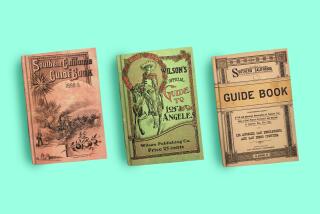Has your guidebook been there, done that?
You’ve been circling unfamiliar back streets for nearly an hour. The seething of your quietly seething companion is no longer quiet, and your legs have gone rubbery from hunger.
Eventually you muster the courage to ask directions in a language not your own. When words fail, you point to your guidebook.
You understand only a sliver of what’s said, but it’s enough to know your luck, which isn’t good.
The cheap, authentic eatery on the quaint back street? It burned down in 1999. And the colorful local who ran it? He’s driving a cab in St. Louis.
Guidebook authors feel your pain. On assignment for Lonely Planet, publisher of more than 500 titles geared to the independent traveler, I typically carry five or more guidebooks, not just to gather leads but also to help in the search for my own food and shelter. Many times, I am led to unexpected delights. Other times I am simply led astray.
But I shall not cast the first stone. I know, for example, that when a book hits the shelves, the information is probably 6 months old, sometimes more -- a reality of book publishing.
And certain publishers pay so little that authors must use phone and Internet to update instead of costly on-the-ground research.
“When I told my editor . . . that I couldn’t afford to visit the towns I was covering, she told me flat out, ‘Just call,’ ” said former guidebook author John Vlahides.
Even when budgets allow travel, writers are tasked with the impossible. People often ask me whether I eat in every restaurant or sleep in every hotel I review. When I do the math, they realize that to do so I’d be obese and broke.
Aware of these limitations, guidebook authors, myself included, learn quickly how to read between the lines to determine whether content is likely to be useful, mere fluff or just plain wrong. Here are a few of our tricks on what to look for.
The familiar: It’s hard to evaluate information about a region you’ve never visited. But you can examine titles by the same author or publisher that cover somewhere you do know, whether it’s Paris or your own hometown. Usually you can quickly deduce whether the content is trustworthy and a match for your own needs and preferences.
The author bio: “I always look at author bios,” says Laura Dunston, who has co-written more than 15 titles for Lonely Planet and the lavishly illustrated Eyewitness travel series. She prefers authors who live in the region they cover, or at least who love it and return regularly.
The details: “Someone who hasn’t visited a place can’t catch specifics -- graffiti on the restaurant walls, a bulldog named Pete or a bar’s back room with sticky floors and a 1981 Space Invaders video game,” says Robert Reid, who has worked on a dozen Lonely Planet titles as well as his own web- site, www.reidontravel.com, devoted to travel in Vietnam.
“But also beware mere laundry lists of amenities,” adds Zora O’Neill, who has written guides for Lonely Planet and Moon and Rough Guides, whose guides specialize in independent, off-the-beaten-track travels.
“That information can easily be culled from a website. Ideally, you want a little portrait of what it’s like actually to be there.”
The human touch: “I like to see reviews that mention actual people,” O’Neill says. “If it’s a restaurant, I want to know who eats there and what kind of people will serve you.” The presence of human beings indicates the person was on the premises.
The location: If a destination is hard for you to reach, it’s also hard for a guidebook author. That could mean destinations off the beaten track are more likely to be wrong because the author may not be able to go there, may not have sufficient info or may have trouble reaching sources.
When traveling to such places with important contingencies -- a must-see annual event or a difficult onward connection you can’t afford to miss -- conduct your own research.
The Pollyanna syndrome: “I watch out for overly positive reviews,” says Reid. “This can be ‘press-releasey,’ perhaps even lifted from a website.”
A breathless tone also is a mistake that novice writers, awed by the idea of getting paid to travel, sometimes make, Reid says.
--
More to Read
Sign up for The Wild
We’ll help you find the best places to hike, bike and run, as well as the perfect silent spots for meditation and yoga.
You may occasionally receive promotional content from the Los Angeles Times.






